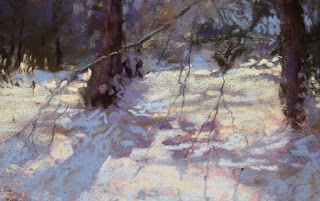 |
| Detail from Chattahoochee Snow, oil |
Those reading this who have taken a workshop from me know that I make a big deal about each and every mark you make on your painting. Even though I've been teaching this for awhile, I've come to realize even more so that the individual characteristics of your mark making are what eventually elevate you to a higher skill level.
 |
| Detail of a limited stroke pastel demo. |
Truthfully, until fairly recently, I was never all that impressed when artists (often even my favorites) posted zoomed in detail images of their work...typically oil painting brushwork, but also pastel work.
As I've continued to teach mark-making exercises to students, I find that I realize even more so the importance of allowing our medium of choice to do what it does, and to not always try to overly render it to replicate the subject matter. I find myself telling students, "let paint do what paint DOES."
For example, when you see images used to advertise pastels, you usually see a fresh, clean, "unfussed with" swipe of a pastel that clearly shows the characteristically soft, buttery stroke that a soft pastel makes. It doesn't try to completely cover up the underlying surface, but allows the surface to show through, with the mark and substrate working together as a little piece of artwork. Or you'll see a brushstroke of paint coming from a loaded brush that allows the paint to be thin in some places and thick in others...all in that one stroke that was cleanly applied and left alone. With either medium, it's the imperfections of the paint/pastel application that often enhance the artwork. This is of course more so in impressionist work.
But while we work hard to control our medium of choice, the really hard part is learning what NOT to control so that our medium can be free to show off its unique characteristics to which we as artists are attracted in the first place. Areas of a painting that I first thought I goofed when applying a wayward stroke, if left alone, have often become my favorite part of the painting.
Sometimes purposefully applied marks on a painting are referred to as calligraphy when they have a clean, poetic quality to them. And just like learning good penmanship as a child, it takes years of practice to learn the nuances of applying your own characteristic marks to your work....
- How to hold your brush, pastel, pen, pencil, palette knife etc.
- How much pressure to apply
- How long or short of a mark to make
- Which direction to apply it
- How fast or slow to apply it
- How thinly or thickly to apply the pigment
- Connect the marks or make them individually?
I could go on, but you get the idea.
As I've learned to become more thoughtful to the marks I make on my own work, I've discovered that I can better appreciate seeing those zoomed in detail portions from the work of my favorite artists, and observe how the sensitive application and behavior of the pigment is as much a part of the artwork as is the subject mater and other important artistic elements (value, temperature, chroma, composition, edges). Lately I've been scrutinizing my own mark making even more. And when I look at the work of my favorite artists, I find that, in addition to observing the other artistic elements, I'm especially noticing the mark making.
Shown in this post are detail images from a few of my pastel and oil paintings completed in the past couple of years. These are pieces in which I was satisfied with the variety of marks and handling of the medium. In each of them, I think I was more thoughtful to each mark I placed in the painting, and therefore didn't go back over strokes to "fix" them.
 |
| Detail from Winter's Grace, oil |
 |
| Detail from Daybreak Shadows, pastel |
In this continuous quest to push my own painting skills, I'm discovering that perhaps skillful mark making is indeed the most difficult (and often last) skill that an artist can begin to master. And one that usually places one artist a notch above another.
Upcoming Workshops:
Cincinnati, OH - 3-day PASTEL/OIL workshop
Jan. 22, 23 & 24, 2016 (Fri/Sat/Sun)
Cincinnati Art Club
1021 Parkside Place (beautiful, historic Eden Park area near downtown Cincinnati)
Cincinnati, OH 45202
$400/member; $425/nonmember
Bridgewater, NJ - 3-day PASTEL/OIL workshop
Feb. 26, 27 & 28, 2016 (Fri/Sat/Sun)
York Art Studio
350 Grove St. #4, Bridgewater, NJ 08807
yorkartstudio@gmail.com
908-392-0998
$400
Payment will be made to Barbara Jaenicke. Contact Barbara directly at barbarajaenicke@msn.com to register.
Mt. Vernon, WA - 3-day PASTEL workshop
March 10, 11 & 12, 2016 (Fri/Sat/Sun) - these dates have shifted slightly from what was previously promoted!
Dakota Art Center
17873 State Route 536
Mount Vernon, WA 98273
$395
888-345-0067 ext. 5
Critique Services
Would you like me to personally critique your oil or pastel painting? Visit www.ProArtCritique.com and click on my name for quick, affordable feedback on your work!